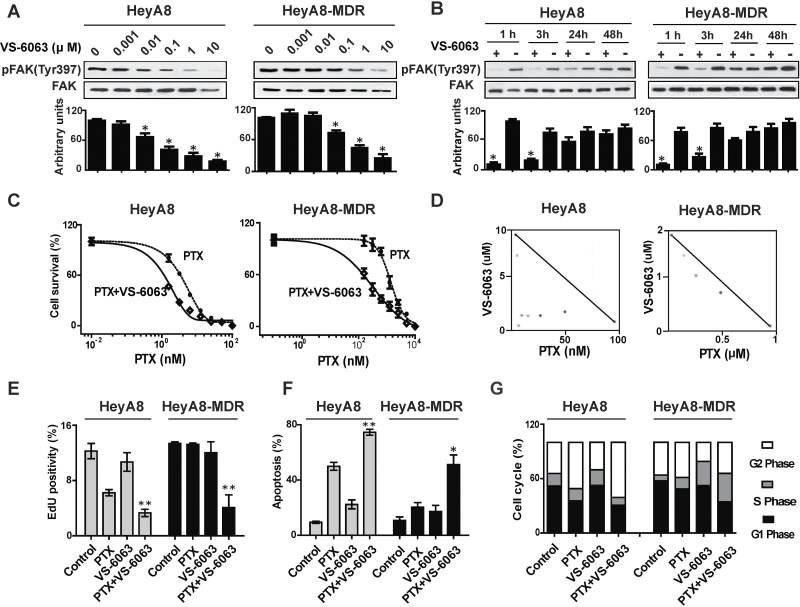This product is for research use only, not for human use. We do not sell to patients.

| Size | Price | Stock |
|---|---|---|
| 500mg | $550 | In Stock |
| 1g | $900 | In Stock |
| 5g | $2275 | In Stock |
Cat #: V0663 CAS #: 1073154-85-4 Purity ≥ 98%
Description: Defactinib (formerly known as VS-6063, PF-04554878) is a selective, ATP-competitive and orally bioactive small molecule inhibitor of the FAK (focal adhesion kinase) with potential antitumor activity. It inhibits the phosphorylation of FAK at the Tyr397 site in a time- and dose-dependent manner. FAK is a nonreceptor tyrosine kinase that plays a vital role in many oncogenic pathways. Increased FAK expression has been reported in a number of tumor types, including breast, colon, and ovarian cancers. Therefore, as an inhibitor of FAK, defactinib has potential antineoplastic activities.
References: [1]. Kang Y, et al. Role of focal adhesion kinase in regulating YB-1-mediated resistance in ovarian cancer. J Natl Cancer Inst. 2013 Oct 2;105(19):1485-95.
Publications Citing InvivoChem Products
Product Promise

- Physicochemical and Storage Information
- Protocol
- Related Biological Data
- Stock Solution Preparation
- Quality Control Documentation
| Molecular Weight (MW) | 510.49 |
|---|---|
| Molecular Formula | C20H21F3N8O3S |
| CAS No. | 1073154-85-4 |
| Storage | -20℃ for 3 years in powder formr |
| -80℃ for 2 years in solvent | |
| Solubility In Vitro | DMSO: 5 mg/mL (9.8 mM)r |
| Water: <1 mg/mLr | |
| Ethanol: <1 mg/mL | |
| Solubility In Vivo | 5% DMSO+50% PEG 300+5% Tween 80+ddH2O: 5mg/mL |
| SMILES Code | O=C(NC)C1=CC=C(NC2=NC=C(C(F)(F)F)C(NCC3=NC=CN=C3N(C)S(=O)(C)=O)=N2)C=C1 |
| Synonyms | VS-6063; PF-04554878; VS6063; VS 6063; PF04554878; PF 04554878; PF4554878 |
| Protocol | In Vitro | In vitro activity: In taxane-sensitive (SKOV3ip1) and taxane-resistant (SKOV3-TR) cell lines, Defactinib significantly inhibits pFAK (Tyr397) expression. The combination of Defactinib and paclitaxel synergistically decreases proliferation and increases apoptosis in SKOV3ip1, SKOV3-TR, HeyA8 and HeyA8-MDR cells. The combination of Defactinib and Y15 synergistically decreases viability, clonogenicity, and cell attachment in thyroid cancer cell lines. Kinase Assay: Defactinib inhibited FAK phosphorylation at the Tyr397 site in a time- and dose-dependent manner. The combination of Defactinib and paclitaxel markedly decreased proliferation and increased apoptosis, which resulted in 92.7% to 97.9% reductions in tumor weight. RPPA data showed that Defactinib reduced levels of AKT and YB-1 in taxane-resistant cell lines. FAK inhibition enhanced chemosensitivity in taxane-resistant cells by decreasing YB-1 phosphorylation and subsequently CD44 in an AKT-dependent manner. In human ovarian cancer samples, nuclear FAK expression was associated with increased nuclear YB-1 expression (χ²) = 37.7; P < .001). Coexpression of nuclear FAK and YB-1 was associated with statistically significantly worse median overall survival (24.9 vs 67.3 months; hazard ratio = 2.64; 95% confidence interval = 1.38 to 5.05; P = .006). Cell Assay: Ovarian cancer cells are treated with increasing concentrations of Defactinib for 96 hours and then subjected to the MTT assay. Results are confirmed with triplicate experiments. |
|---|---|---|
| In Vivo | In both PTX-sensitive and PTX-resistant models, Defactinib (50 mg/kg p.o.) enhances tumor growth inhibition by paclitaxel. | |
| Animal model | Mice bearing SKOV3ip1, SKOV3-TR, HeyA8 or HeyA8-MDR tumors | |
| Formulation | Dissolved in PBS | |
| Dosages | 50 mg/kg; Administered through p.o. |
| Solvent volume to be added | Mass (the weight of a compound) | |||
|---|---|---|---|---|
| Mother liquor concentration | 1mg | 5mg | 10mg | 20mg |
| 1mM | 1.9589 mL | 9.7945 mL | 19.5890 mL | 39.1780 mL |
| 5mM | 0.3918 mL | 1.9589 mL | 3.9178 mL | 7.8356 mL |
| 10mM | 0.1959 mL | 0.9795 mL | 1.9589 mL | 3.9178 mL |
| 20mM | 0.0979 mL | 0.4897 mL | 0.9795 mL | 1.9589 mL |
This equation is commonly abbreviated as: C1 V1 = C2 V2
- (1) Please be sure that the solution is clear before the addition of next solvent. Dissolution methods like vortex, ultrasound or warming and heat may be used to aid dissolving.
- (2) Be sure to add the solvent(s) in order.











































